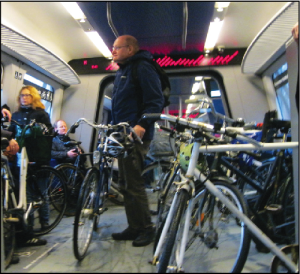
When I last wrote, I had been in Denmark for about two weeks and was just starting to get a feel for my new home. Now just two weeks later, I’ve gotten my footing, and many lifestyle differences that seemed strange at first now feel completely normal. In trying to give you an idea of what life here is like, I find myself also beginning to answer the question I posed in my first column: why is Denmark consistently ranked as one of the “happiest countries on earth?”
On the surface, Americans would find many Danish practices quite inconvenient. Water and utilities are taxed at an incredibly high rate to promote sustainability and to support other social services. As a result, Danes take very short showers with water at lower temperatures. With effort (and practice before I arrived!), I am proud to report that I can now shower in four minutes – start to finish. I dry my clothes on drying racks in front of the living room fireplace (which is also used to heat the home). Not as fast as a dryer, but certainly fast enough.
From an American perspective, these minor inconveniences pale by comparison with more significant lifestyle differences. For starters, Danes drive a lot less than Americans. There are several reasons for this, the first being that there is a 180% tax on the purchase of a car! And once you own the car, gas prices are (by our standards) insane! One gallon of gas costs approximately $8.29! As a result, Danes find alternative modes of transportation, primarily public transit and biking – especially biking. People bike everywhere!
The Danes bike in the snow, rain, and sleet. They bike with their children, groceries and Christmas trees in attached carts. There are special bike lanes with mini-traffic lights running through cities and alongside roads. And rather than being seen as an inconvenience, biking is often the fastest way to get around and seems to contribute to the overall well-being. One Dane told me, “I feel a lot better when I arrive at work having just biked there, rather than sitting in traffic on the highway.” I have noticed a difference in my own energy level as I’ve started biking as often as possible; yes, even in the rain, sleet and snow.
Danish biking habits are just one aspect of the broader commitment to health. Each member of my host family plays a different sport including soccer, volleyball, running and horseback riding. When ill, no one worries about paying for medical care. Danish citizens have all of their healthcare needs met; in fact, as a temporary Danish citizen even I have free healthcare! Their Social Welfare system does come at a high price; income tax can reach nearly 50 percent and sales tax is (usually) 25 percent. Most Danes see this as more than worth it. In times of illness, unemployment and other life crises, they know that their basic needs will be taken care of.
The tax-supported Social Welfare system brings other important benefits: all education is free, including post-high school education; both mothers and fathers have extended, paid family leave after the birth of a child; and there is very little homelessness or extreme poverty within Denmark. There are certainly variations in income and wealth, but radical differences between rich and poor do not exist.
When I asked my host family whether they are bothered by people who take advantage of the Welfare System, they answered: Yes, but just because a few people take advantage, it doesn’t mean that it shouldn’t exist. For the Danes, the overriding sense of security and trust they experience removes major sources of stress and enables them to more fully enjoy their lives. This sense of trust and connection with the broader community is reflected in other ways, too. Parents leave babies in strollers outside cafes while they grab a bite to eat and young children take public transit to school by themselves.
I understand that this system would not work in the US as it does here. The size and diversity of the US – 300 million people, compared to Denmark’s 5.5 million – lead to differences in culture and values that Danes don’t have to grapple with (or benefit from). And as wonderful as it may sound, I am also learning that Denmark is not perfect. Still there is a lot we could learn from the Danes. And as for the broader issue of what leads to happiness… I’ve learned that clearly individual happiness depends only partly on one’s circumstances, environment and material well-being. This, in fact, has been the focus of my academic studies here in CPH. But more about that next time!


